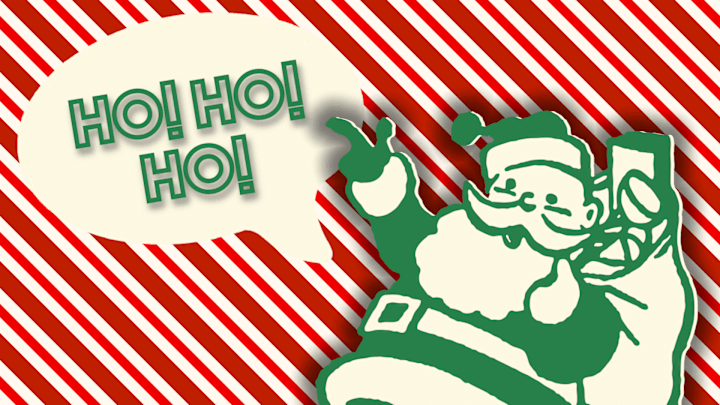The strange habits of Santa Claus are ripe for interrogation, from his use of the chimney as a thoroughfare to his use of coal as a disciplinary measure. His trademark ho ho ho raises questions, too, such as: What?
It’s generally agreed that when Jolly Old St. Nick spouts a trichotomous ho, he’s laughing with mirth. But the history of ho ho ho as laughter—and how it became Santa’s catchphrase—is a little more complicated than that.
The Trick Factor
According to the Oxford English Dictionary, a double or triple ho was used to express “derision or derisive laughter” possibly as far back as the late 12th century, and it was definitely in play by the 16th century. A solitary ho, meanwhile, could connote “surprise, admiration, exultation (often ironical), triumph, [or] taunting.”
While Papa Noël doesn’t taunt or deride, there is something pretty puckish about the way he steals undetected into and out of people’s houses at night, and getting away with that kind of benevolent mischief certainly merits a triumphant ho or three. In fact, the mythos of Santa Claus involves quite a bit of trickery on all sides—from parents trying to keep their kids from finding out the truth to kids trying to catch the bearded anti-burglar in the act.

Early mentions of ho ho ho in conjunction with Father Christmas—though not all spoken by him—reflect that theme. In 1877, for instance, newspapers printed a story by John Brownjohn in which a young believer by the name of Miltiades Peterkin Paul sticks a steel trap down his stocking in the hopes that it will ensnare Santa’s hand.
“Then I’ll hurry downstairs in an instant and free him. Ho! ho! ho! We’ll soon know if a body may see him,” he says. (It isn’t Santa that Miltiades captures, but his own grandfather.)
Ten years later, The Clyde Mail of Kansas printed an ad written from the perspective of Santa Claus, who had just “delivered” toys and other goods to a local store in early December.
“Ha! Ha! Ha! Ho! Ho! Ho!” Santa says, “Howdy, Children! Didn’t Look for Me so Soon, Did You!”
You May Also Like ...
- Why Does Santa Claus Live at the North Pole?
- Why Did NORAD Start Tracking Santa?
- Why Does Santa Claus Give Coal to Bad Kids?
Add Mental Floss as a preferred news source!
Canned Laughter
Ho ho ho’s connection to Santa Claus continued to grow stronger even as its lexical nuances began to fade. And that’s largely because it was kept alive in Santa-specific songs and stories.
In 1867, for example, William B. Bradbury published a hymnal that included a song about Kris Kringle and his Christmas tree. “Oh ho, Oh ho, ho, ho, ho, ho, ho, ho, ho, ho,” you’d sing, followed by a number of jingles.
The previous year, Benjamin Russell Hanby had published the music and lyrics for “Santa Claus”—a ditty known better today as “Up on the Housetop.” In Hanby’s original iteration, the line in question was “O! O! O! Who wouldn’t go.” But by the dawn of the 20th century, songbooks had already started replacing the o’s with hos. And when Gene Autry released his famous rendition in 1953, it was actually titled “Up on the House Top (Ho! Ho! Ho!).”
The Wonderful Wizard of Oz author L. Frank Baum contributed to the popularity of the expression, too. In his 1902 children’s book The Life and Adventures of Santa Claus, the titular character bellows this jolly song as his sleigh takes off:
“With a ho, ho, ho!
And a ha, ha, ha!
And a ho, ho, ha, ha, hee!
Now away we go
O’er the frozen snow,
As merry as we can be!”
It would still be a while before ho ho ho fully supplanted ha ha ha as Santa’s go-to guffaw. In Disney’s 1932 animated short Santa’s Workshop, for example, Santa Claus very clearly exclaims “Ha! Ha! Ha!” rather than “Ho! Ho! Ho!” as he peruses letters and inspects toys.
But the interjection’s association with jolliness was solid enough by the mid-20th century that when vegetable manufacturer Green Giant created a jingle for the Jolly Green Giant in the early ’60s, producers had vocalist Len Dresslar record a booming ho ho ho to slot in after the word jolly.
The Jolly Green Giant’s appropriation of the phrase didn’t seem to weaken Santa’s brand. And judging by the number of 6-year-olds today who will answer your “Who says ho ho ho?” with a resounding “Santa!,” it’s clear who got the last laugh.
A version of this story originally ran in 2022; it has been updated for 2025.
